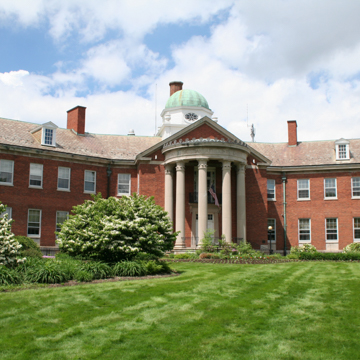Shaker Heights City Hall is a public building designed for the master planned garden suburb, in which municipal, institutional, and commercial buildings were all intended to embody the same stylistic references and physical characteristics as the community’s residential properties. To that end, they employ brick, stone, and stucco, and display Colonial Revival porticos and dormers, Tudor–style half-timbering, or French-inspired turrets and slate roofs. For the 1930 City Hall, architect Charles S. Schneider drew from Colonial American precedents to create a dignified but restrained composition focused on a semicircular two-story stone portico and octagonal copper-roofed cupola at the center of a symmetrical red brick facade. Colonial Revival architectural details are found on the interior public spaces as well. The main entrance lobby and City Council chambers feature decorative moldings, cornices, columns, and pilasters.
The building is set well back from the intersection of Van Aken Boulevard and Lee Road and is angled to acknowledge its somewhat triangular site. It sits somewhat elevated, on a rise above the intersection, with a broad two-tiered grass lawn sloping up to its front entrance, adding to its visual prominence and stately character. Incorporated as a village in 1911, the municipal government nonetheless confidently inscribed the words “City Hall of Shaker Heights” on the portico frieze. It would not reach “city” status until after the building was completed, when the results of the decennial census (released in 1931) confirmed that Shaker Heights had reached the required population. Shaker Heights City Hall remains in use as the primary administrative building for the municipal government, and its original architectural features are well preserved.
References
Forgac, Patricia J., “Shaker Village Historic District,” Cuyahoga County, Ohio. National Register of Historic Places Inventory-Nomination Form, 1984. National Park Service, U.S. Department of the Interior, Washington, D.C.
Harwood, Herbert H. Jr. Invisible Giants: The Empires of Cleveland’s Van Sweringen Brothers. Bloomington: Indiana University Press, 2003.
Johannesen, Eric. Cleveland Architecture, 1876-1976. Cleveland: The Western Reserve Historical Society, 1976.
Johannesen, Eric, “Shaker Square Historic District,” Cuyahoga County, Ohio. National Register of Historic Places Inventory-Nomination Form, 1983. National Park Service, U.S. Department of the Interior, Washington, D.C.
Marshall, Bruce T. Shaker Heights. Charleston, SC: Arcadia Publishing, 2006.

